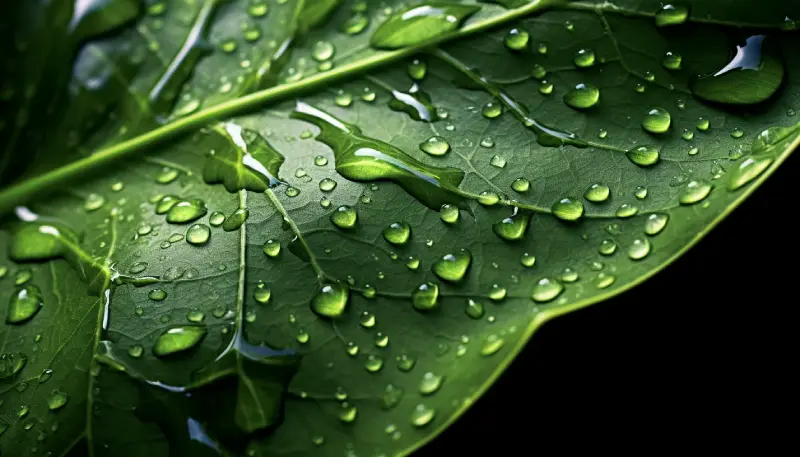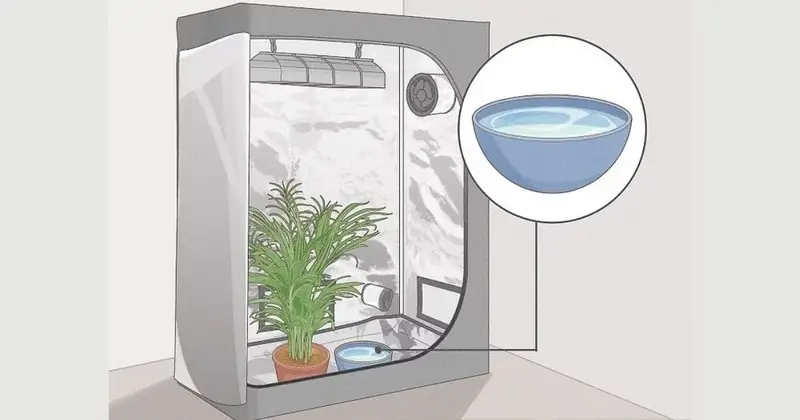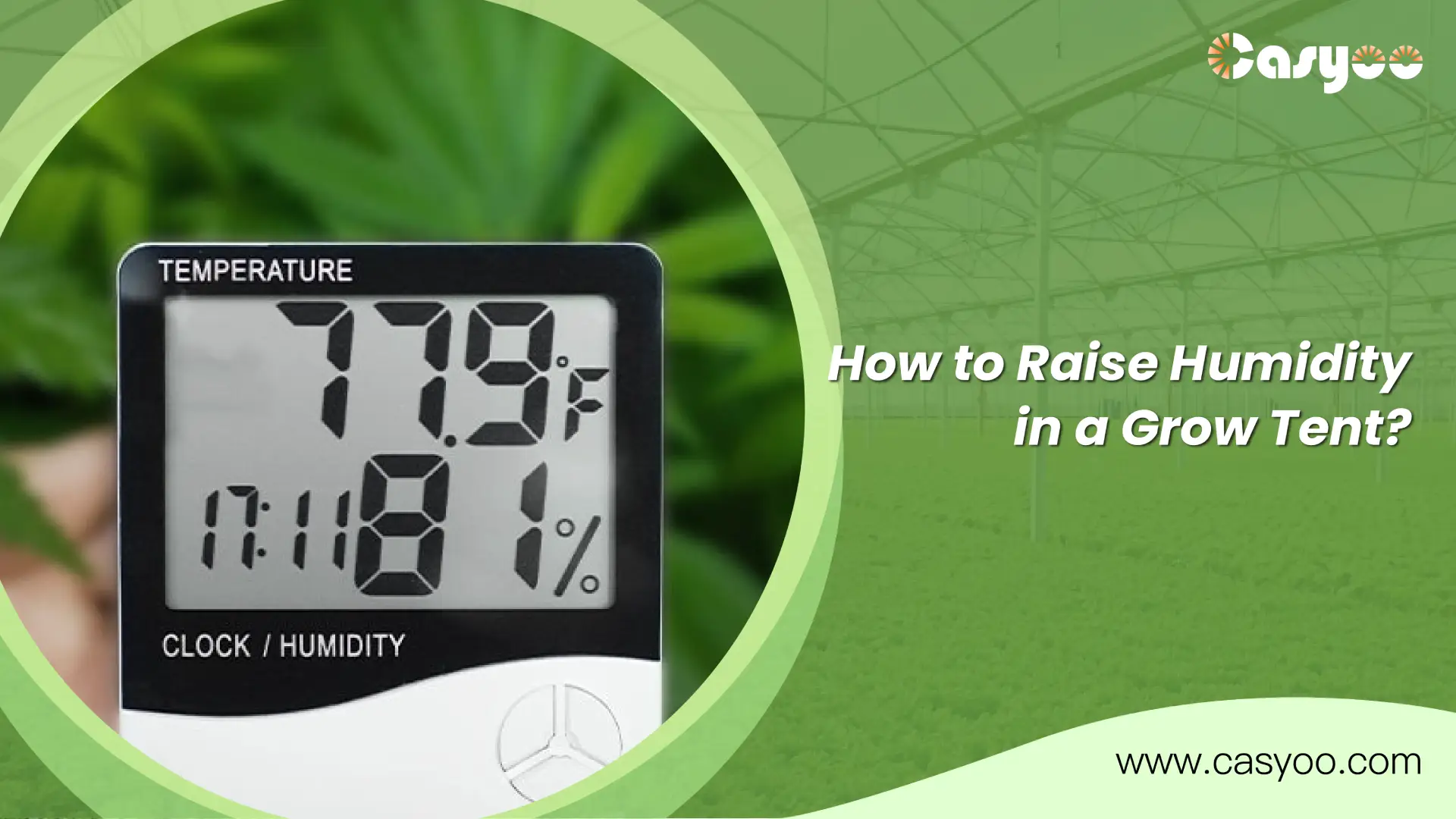Grow tents are a great way to grow plants, and once you master some of the necessary growing tips, such as grow spectrum, hanging height, and grow tent temperature, you will achieve some amazing results. However, the environment can be difficult to control. As plants grow, their requirements for humidity levels may change, making it essential to be flexible in setting humidity. In this article, we will talk about the significance of humidity levels to your plants and come up with ways to raise the humidity in your grow tent to ensure your plants thrive.
What is relative humidity and absolute humidity?
Though absolute humidity and relative humidity indicate the amount of water vapor in the air, they are not the same concept.
Relative humidity
Relative humidity, abbreviated as RH, is the percentage difference between the saturated water vapor density at a certain temperature and the actual water vapor density in the air. It is expressed as a percentage (%), rounded to an integer. The air is more humid and has a higher water vapor content when the relative humidity is higher.
Absolute humidity
Absolute humidity is the mass of water vapor contained in a unit of air. It is a physical representation of the atmosphere’s moisture and dryness, typically given in grams of total water vapor per cubic meter. Since the pressure of water vapor increases with density, the absolute humidity of the air can usually be expressed in terms of pressure.
The difference between the two is that absolute humidity does not change with temperature and climate change, while relative humidity changes qualitatively with rising and falling temperatures. Usually, relative humidity decreases with rising temperatures.
In a grow tent, we focus on relative humidity because it can better understand how favorable a closed environment is for plant growth.
Why is humidity important to plant growth?

Humidity refers to the amount of water vapor in the air, usually expressed as a percentage. The impact of humidity on plant growth is mainly reflected in the following aspects:
Transpiration
Plants release water through stomata to form water vapor, which affects air humidity. When the air humidity is high, the transpiration of plants weakens and water loss decreases; conversely, when the air humidity is low, the transpiration of plants strengthens, and water loss increases.
Water absorption
Plants absorb water from the soil through their roots to meet their own growth needs. High or low air humidity will affect soil moisture content, thereby affecting plant water absorption.
Plant diseases
Excessive air humidity may lead to the occurrence of plant diseases, such as mold, bacteria, and other pathogenic microorganisms that are easy to breed in a humid environment, affecting plant health.
What are the symptoms of low humidity in plants?

If you notice signs of low humidity in your plants, it may not be due to insufficient watering or insufficient light. A surefire way to determine if your plant is in an environment with insufficient humidity is to accurately measure indoor humidity levels using a hygrometer.
For physical indicators, symptoms that may indicate low humidity in plants include:
- Brown or crisp leaves
- Shriveled or curled leaves
- Withered leaves and stems
- Leaf scorch (browning of leaf edges and tips, yellowing or blackening of veins)
What are the humidity requirements of different plants?
- Cacti and succulents: These plants are native to arid areas and have low humidity requirements, generally around 30%. Excessive humidity may cause root rot in plants.
- Tropical plants: Such as pitcher plants, ferns, etc., which come from tropical rainforest areas, have high humidity requirements, generally above 80%. In a dry environment, these plants may not grow normally.
- Evergreen ornamental plants: Such as pennywort, rubber tree, etc., have humidity requirements are between the above two types of plants, generally 60%-70%. These plants can grow well in a suitable humidity environment.
- Flowers: Different types of flowers have different requirements for humidity. Generally speaking, at temperatures between 15°C and 28°C, relative humidity should be maintained between 60% and 70%. During the planting process, the humidity of the surrounding environment should be adjusted in time according to the different requirements of flowers for air humidity.
How to increase the humidity in the grow tent?

Add a humidifier
A humidifier is a quick and direct way to increase the indoor humidity level of a growing room, tent, or hydroponic garden. A humidifier can release moisture into the air, which can raise humidity levels and produce the perfect environment for plant growth, especially in the winter when humidity drops drastically.
Compact indoor humidifiers are usually sufficient for smaller tents or basement growing rooms. However, commercial growers may need a ducted humidifier that can cover the entire facility.
If the tropical plants you grow thrive in warm air, consider using a humidifier with a warm mist function.
Here are some things to note when using a humidifier:
- Water selection: Use filtered or distilled water instead of tap water in a humidifier to provide the best quality moisture for your plants.
- Built-in humidifier: Many modern humidifiers have a built-in humidifier that provides real-time information about the humidity level in the grow tent.
- Use with a fan: Place a fan near the humidifier to increase moisture circulation, ensuring that moisture is evenly circulated throughout the grow space.
- Ultrasonic humidifier: This device reintroduces moisture without changing the room temperature. It can run for up to eight hours and features a huge water tank and directional mist outlet.
Place a water source near the plants
It will assist in raising the grow tent’s humidity level.
Here’s how:
Hanging wet towels
Hanging wet towels will temporarily increase humidity. Soak the towels in water and then hang them near the vents on both sides of the grow tent. When air enters the tent, it contacts the towels. The moisture will then evaporate from the towels and release into the surrounding air, increasing the humidity in the grow tent. Keep the towels away from the grow lights to avoid burning them.
Towels are not a permanent solution, but they can quickly increase moisture. Growers can use towels in any tent type as long as they have a place to hang the towels.
Fill a bowl or tray with water
To gradually increase humidity, fill bowls or trays with water and place them around the tent. Pay attention to places like large exhaust fans near the ground and vents. As the water evaporates, the humidity level in the grow tent will increase. You can reuse or remove the water bowls when needed. It is a better choice than wet towels for continuously increasing the humidity in the tent.
Place wet sponges
A quick way to replenish evaporated water is to soak sponges in water and place them near fans or vents inside the tent. Airflow and heat evaporate the water, increasing humidity. And gardeners can easily place them around plants.
Alternatively, you can place sponges in a bowl or tray filled with water to speed up evaporation. Sponges dry faster than water bowls and help the moisture spread quickly. You can also place them closer to plants for efficient moisture distribution.
Introduce larger plants into your grow tent
Increasing plant density is also a viable option. As you add more plants, the relative humidity in the grow tent will increase. Different plants, especially large plants, have larger leaves and more stomata, so they breathe more strongly, releasing large amounts of water vapor and carbon dioxide, which increases humidity. But be careful not to overdo it. Too many large plants will limit the ability to provide nutrients and airflow to the seedlings and affect their growth. To ensure that the plants get an even amount of light and nutrients, don’t overcrowd the plants.
Reduce fan speed
Adjusting ventilation is also an effective way to increase relative humidity and successfully grow plants in the grow tent. Without proper ventilation, there is not enough air exchange, which hinders the health of the plants. Typically, growers set the fan speed to a medium level to maintain humidity during different stages of plant growth. However, if the fan is set to high speed, two problems will occur:
- The air will dry out quickly, resulting in very low humidity in the grow tent.
- The water vapor will not have enough time to condense on the leaves, resulting in insufficient moisture and dehydrated plants.
So, what should growers do in this case?
The answer is to set the fan speed to the lowest possible level. This action will reduce air circulation in the grow tent and increase relative humidity. However, keep in mind that you may not be able to increase humidity to 70% using this method alone.
Here are ways to adjust fan speeds to increase humidity:
- Reduce the speed of the ventilation fan near the ceiling of your tent, as it will draw out stale air and moisture.
- Adjust other fans that circulate air between plants to lower levels.
- Temporarily turn off the ventilation system for about an hour each day to quickly increase humidity.
- Avoid turning off fans permanently to ensure a stable temperature throughout the tent.
This method works well for larger tents with adjustable-speed ventilation fans or wall-mounted fans.
Changing the Soil
How can you increase humidity in your grow tent just by adjusting the soil?
Step 1: Choose a soil with good water-holding capacity.
Step 2: Make a walkway or floor with this soil.
Step 3: Create a large water surface area.
This setup will increase the RH inside your grow tent.
When using this method, it is critical to choose a soil with the right water-holding capacity. Although clay holds water best, it can create a soggy environment if used alone. We recommend choosing a mixture of clay and silt to get the right balance.
In addition, this layer of soil is not a growing medium for your plants. So if your plants are already developing in soil, there is no need to change the entire growing medium. Instead, create a false floor with a soil mix to help increase humidity.
Lower the temperature in the grow tent
When the temperature inside the grow tent drops to a certain point, the air becomes more humid. The drop in temperature increases the amount of water vapor that the plants can absorb and produces a lot of moisture, which is beneficial to plant growth at a certain stage. Since the stomata are open, the plants will not dry out and will continue to produce energy through photosynthesis.
You can adjust the temperature of the grow tent by adjusting the settings of the heater or air conditioner. In addition, reducing the intensity of UV rays on the plants can slow down the evaporation of water and help maintain a comfortable temperature.
If lowering the temperature inside the grow tent will put it out of the ideal range for the plants, try not to do it. Lowering the air temperature from your heater or air conditioner causes warmer, more humid air to rise to the top of the tent, while cooler air falls to the bottom. This process makes the air more humid.
Don’t forget grow lights
While light has a small effect on humidity levels at all stages of plant growth, it still has a role to play.
The heat they produce can affect humidity levels. The air within the grow tent may get hotter and dryer if the grow lights produce too much heat, which will drop the humidity levels. However, if there is insufficient heat produced by the grow lights, the air within the grow tent may get colder and more humid, which would increase the humidity levels.
Final thoughts
You should now understand the significance of humidity for plant growth and how to raise the humidity level within your grow tent. By increasing the humidity in your grow tent to the proper level, you will hopefully be able to harvest a healthy, high-quality crop. If you want to know more about the ways to control humidity in your growing space, please contact us.




